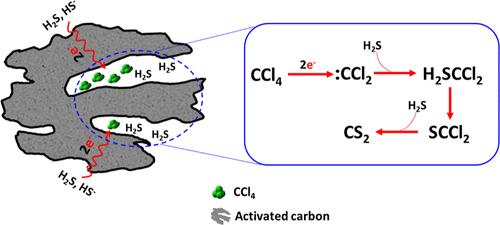当前位置:
X-MOL 学术
›
Environ. Sci. Technol.
›
论文详情
Our official English website, www.x-mol.net, welcomes your
feedback! (Note: you will need to create a separate account there.)
New Mechanism via Dichlorocarbene Intermediate for Activated Carbon-Mediated Reductive Dechlorination of Carbon Tetrachloride by Sulfide in Aqueous Solutions
Environmental Science & Technology ( IF 10.8 ) Pub Date : 2023-09-28 , DOI: 10.1021/acs.est.3c03333 Chenhui Wei 1 , Shu Tao 1 , Dongqiang Zhu 1
Environmental Science & Technology ( IF 10.8 ) Pub Date : 2023-09-28 , DOI: 10.1021/acs.est.3c03333 Chenhui Wei 1 , Shu Tao 1 , Dongqiang Zhu 1
Affiliation

|
Although activated carbon (AC) is widely used as an adsorbent and barrier for contaminated sediment remediation, little attention has been paid to its mediation effects on reductive dechlorination of chlorinated solvents by commonly presenting sulfide. Here, we reported that highly porous, graphitized AC (250 mg L–1) suspended in deoxygenated aqueous solutions could increase the pseudo-first-order rate constant of sulfide-induced dechlorination of carbon tetrachloride (CCl4) by more than 1 order of magnitude. Carbon disulfide (CS2) was the only main product, with no production of chloroform or dichloromethane. The minimum promotion of CCl4 reduction observed with electro-conductive but nonporous graphite and a microporous but electro-insulative resin (XAD-4) indicates that graphitic carbons and micropores both play key roles in AC-mediated dechlorination of CCl4 by sulfide. The detection of dichlorocarbene (:CCl2) by free radical trapping experiments combined with the high suitability of the Langmuir–Hinshelwood model led us to propose a new mediation mechanism: CCl4 molecules adsorbed within the deep regions of AC micropores formed by graphitic carbons accept two electrons transferred from sulfide to form :CCl2, which is impeded from hydrolysis and hydrogenolysis by the hydrophobic micropore and further reacts with sulfide to generate CS2. Consistently, the production of :CCl2 was very low when AC was replaced with graphite or XAD-4. The proposed mechanism was further validated by the enhanced mediation effects of another two carbonaceous materials (template-synthesized mesoporous carbon and covalent triazine-based framework) that are electro-conductive and have well-developed micropore structures. These findings highlight the importance of pore properties of carbonaceous materials as mediators or catalysts for reductive dechlorination reactions and shed light on the development of coupled adsorption-reaction systems for remediation.
中文翻译:

二氯碳烯中间体活性炭介导的硫化物水溶液中四氯化碳还原脱氯新机制
尽管活性炭(AC)被广泛用作污染沉积物修复的吸附剂和屏障,但很少有人注意到它对通常存在硫化物的氯化溶剂还原脱氯的调节作用。在这里,我们报道了悬浮在脱氧水溶液中的高度多孔的石墨化 AC (250 mg L –1 ) 可以将硫化物诱导的四氯化碳 (CCl 4 ) 脱氯的伪一级速率常数提高 1 个数量级以上震级。二硫化碳(CS 2 )是唯一的主要产物,没有产生氯仿或二氯甲烷。使用导电但无孔的石墨和微孔但电绝缘的树脂(XAD-4)观察到的 CCl 4 还原的最小促进表明石墨碳和微孔在 AC 介导的硫化物 CCl 4 脱氯中都发挥着关键作用。通过自由基捕获实验检测二氯卡宾(:CCl 2 ),结合Langmuir-Hinshelwood模型的高度适用性,我们提出了一种新的介导机制:吸附在石墨碳形成的AC微孔深层区域的CCl 4分子接受两个电子从硫化物转移形成:CCl 2,疏水微孔阻碍CCl 2 水解和氢解,进一步与硫化物反应生成CS 2。一致地,当AC被石墨或XAD-4替代时, :CCl 2的产量非常低。另外两种导电且具有发达微孔结构的碳质材料(模板合成的介孔碳和共价三嗪骨架)的增强介导作用进一步验证了所提出的机制。这些发现强调了碳质材料的孔隙特性作为还原脱氯反应的介体或催化剂的重要性,并为用于修复的耦合吸附反应系统的开发提供了线索。
更新日期:2023-09-28
中文翻译:

二氯碳烯中间体活性炭介导的硫化物水溶液中四氯化碳还原脱氯新机制
尽管活性炭(AC)被广泛用作污染沉积物修复的吸附剂和屏障,但很少有人注意到它对通常存在硫化物的氯化溶剂还原脱氯的调节作用。在这里,我们报道了悬浮在脱氧水溶液中的高度多孔的石墨化 AC (250 mg L –1 ) 可以将硫化物诱导的四氯化碳 (CCl 4 ) 脱氯的伪一级速率常数提高 1 个数量级以上震级。二硫化碳(CS 2 )是唯一的主要产物,没有产生氯仿或二氯甲烷。使用导电但无孔的石墨和微孔但电绝缘的树脂(XAD-4)观察到的 CCl 4 还原的最小促进表明石墨碳和微孔在 AC 介导的硫化物 CCl 4 脱氯中都发挥着关键作用。通过自由基捕获实验检测二氯卡宾(:CCl 2 ),结合Langmuir-Hinshelwood模型的高度适用性,我们提出了一种新的介导机制:吸附在石墨碳形成的AC微孔深层区域的CCl 4分子接受两个电子从硫化物转移形成:CCl 2,疏水微孔阻碍CCl 2 水解和氢解,进一步与硫化物反应生成CS 2。一致地,当AC被石墨或XAD-4替代时, :CCl 2的产量非常低。另外两种导电且具有发达微孔结构的碳质材料(模板合成的介孔碳和共价三嗪骨架)的增强介导作用进一步验证了所提出的机制。这些发现强调了碳质材料的孔隙特性作为还原脱氯反应的介体或催化剂的重要性,并为用于修复的耦合吸附反应系统的开发提供了线索。


















































 京公网安备 11010802027423号
京公网安备 11010802027423号